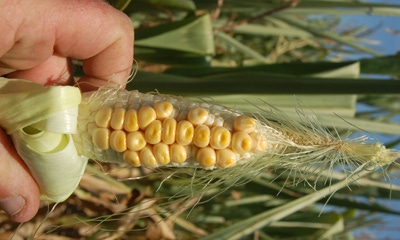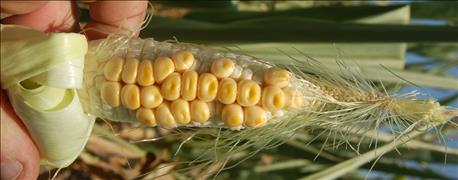
They are out there. Even if your corn makes 200 or more bushels per acre, there are a few bad apples, or in this case, bad ears, in your field. Spot them and diagnose the cause, and you may be on your way to improving yields even more next year.
Here are four problem ears to keep an eye out for this fall.
1. Multiple silks are a bad sign.
Silks still hanging on to ovules on this poorly pollinated ear pictured below tell the story. Ovules with silks were never pollinated, notes Bob Nielsen, Purdue University Extension corn specialist. Obviously, pollen is long gone at this stage. Only the kernels you see will reach black layer.
Dry weather and heat caused this situation.

2. Triple whammy rocks this ear’s world!
That appears to be an insect crawling along the left side of the ear below. It left behind a tunnel, which apparently filled with water, causing sprouting. Disease has also set up in this ear, as denoted by the kernels with a pinkish discoloration.
Dave Nanda, crops consultant for Seed Consultants Inc., sponsor of Crop Watch, says if you find too many ears like this one, you might want to mark the field for early harvest.

3. Here's a double whammy of disease.
The Purdue University Corn and Soybean Field Guide says aspergillus ear rot produces masses of dusty, olive-green spores. Look closely and you will see that type of mold in the center of the ear pictured below. Aspergillus can produce aflatoxin. It’s typically more likely to appear where it was dry during and after pollination.
The whitish mold on this ear is caused by a different type of ear rot.

4. Double duo spells trouble.
The ears pictured below have two distinct problems. Chuck Woloshuk, Purdue University plant pathologist, says the ears on the left with the whitish mold are infested by diplodia ear rot. Note that the infection starts at the base of the ears and moves upward.
The pair of ears on the right show classic examples of gibberella ear rot. This infection starts near the tip of the ear and works toward the base.

(Photo courtesy of Chuck Woloshuk, Purdue University plant pathologist)
About the Author(s)
You May Also Like




